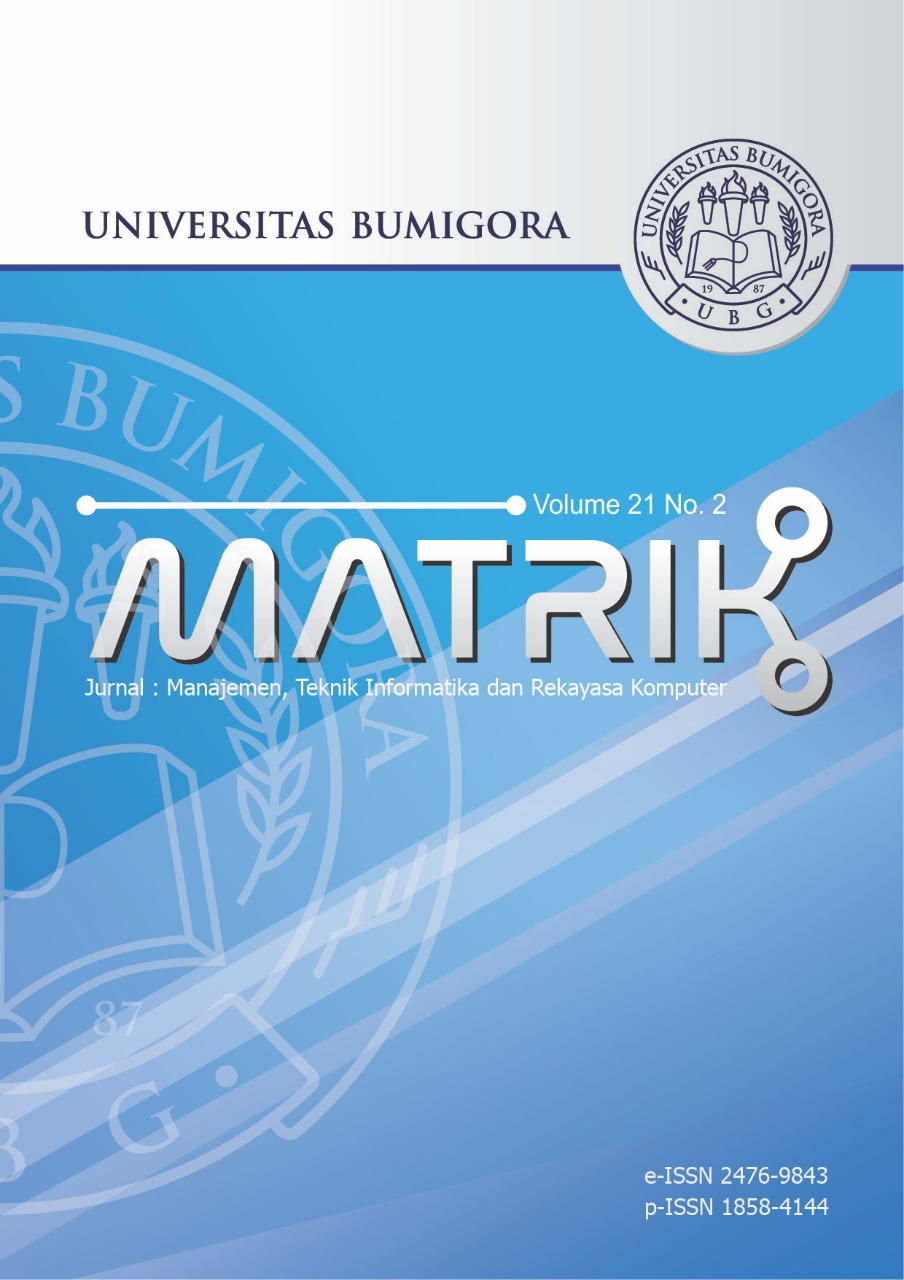Implementation of K-Means Clustering on Poverty Indicators in Indonesia
DOI:
https://doi.org/10.30812/matrik.v21i2.1289Keywords:
Poverty Gap Index, Poverty Severity Index, K-Means, Machine Learning, Cluster AnalysisAbstract
This study aims to cluster all districts/cities in Indonesia related to poverty indicators. The attributes used are poverty gap index and poverty severity index. The data used comes from BPS. The method used is K-Means clustering, and the results show that by using the elbow and silhouette index methods, the optimal number of clusters is 2, where for cluster 1, it can be defined as a cluster with an area with a high poverty gap index and poverty severity index compared to cluster 2. As a result, cluster 1 has 42 districts/cities, and 472 for cluster 2.
Downloads
References
[2] B. Poerwanto, R. Y. Fa’rifah, W. Sanusi, and S. Side, “A matlab code to compute prediction of survival trends in patients with DHF,†Journal of Physics: Conference Series, vol. 1028, no. 1, pp. 1–7, Jun. 2018.
[3] M. Barchitta et al., “Cluster analysis identifies patients at risk of catheter-associated urinary tract infections in intensive care units: findings from the SPIN-UTI Network,†Journal of Hospital Infection, vol. 107, pp. 57–63, Jan. 2021.
[4] Y. Meng, J. Liang, F. Cao, and Y. He, “A new distance with derivative information for functional k-means clustering algorithm,†Information Sciences, vol. 463–464, pp. 166–185, Oct. 2018.
[5] S. Askari, “Fuzzy C-Means clustering algorithm for data with unequal cluster sizes and contaminated with noise and outliers: Review and development,†in Expert Systems with Applications, Mar. 2021, vol. 165, pp. 1–71.
[6] B. Poerwanto and R. Y. Fa’rifah, “Analisis Cluster K-Means dalam Pengelompokan Kemampuan Mahasiswa,†Indonesian Journal of Fundamental Sciences, vol. 2, no. 2, pp. 92–96, 2016.
[7] J. Heil, V. Häring, B. Marschner, and B. Stumpe, “Advantages of fuzzy k-means over k-means clustering in the classification of diffuse reflectance soil spectra: A case study with West African soils,†Geoderma, vol. 337, pp. 11–21, Mar. 2019.
[8] V. Heidrich-Meisner and R. F. Wimmer-Schweingruber, Solar wind classification via k-means clustering algorithm. Elsevier Inc., 2018.
[9] B. Poerwanto, “Evaluating the K-Means Analysis in Clustering Area Based on Estates Productivity in Tana Luwu Using Silhouette Index,†Journal of Physics: Conference Series, vol. 1752, no. 1, pp. 1–7, Feb. 2021.
[10] M. Moatsos and A. Lazopoulos, “Global poverty: A first estimation of its uncertainty,†World Development Perspectives, vol. 22, pp. 1–16, Jun. 2021.
[11] BPS, Berita Resmi Statistik. Jakarta: Badan Pusat Statistika, 2020.
[12] A. T. Rahman, Wiranto, and A. Rini, “Coal Trade Data Clustering Using K-Means (Case Study Pt. Global Bangkit Utama),†ITSMART: Jurnal Teknologi dan Informasi, vol. 6, no. 1, pp. 24–31, 2017.
[13] Y. Hozumi, R. Wang, C. Yin, and G.-W. Wei, “UMAP-assisted K-means clustering of large-scale SARS-CoV-2 mutation datasets,†Computers in Biology and Medicine, vol. 131, pp. 1–14, Apr. 2021.
[14] M. A. Nahdliyah, T. Widiharih, and A. Prahutama, “Metode K-Medoids Clustering dengan Validasi Silhouette Index dan C-Index,†Jurnal Gaussian, vol. 8, no. 2, pp. 161–170, 2019.
[15] N. Chalid and Y. Yusuf, “Pengaruh Tingkat Kemiskinan dan Tingkat Pengangguran, Upah Minimun Kabupaten/Kota Dan Laju Pertumbuhan Ekonomi Terhadap Indeks Pembangunan Manusia di Provinsi Riau,†Jurnal Ekonomi, vol. 22, no. 2, pp. 1–12, 2014.
[16] A. Artino, B. Juanda, and S. Mulatsih, “The Relationship of Village Funds to Poverty,†Tataloka, vol. 21, no. 3, pp. 381–389, 2019.
Downloads
Published
Issue
Section
How to Cite
Similar Articles
- Christofer Satria, Peter Wijaya Sugijanto, Anthony Anggrawan, I Nyoman Yoga Sumadewa, Aprilia Dwi Dayani, Rini Anggriani, Multi-Algorithm Approach to Enhancing Social Assistance Efficiency Through Accurate Poverty Classification , MATRIK : Jurnal Manajemen, Teknik Informatika dan Rekayasa Komputer: Vol. 24 No. 1 (2024)
- Paska Marto Hasugian, Devy Mathelinea, Siska Simamora, Pandi Barita Nauli Simangunsong, Comparative Evaluation of Data Clustering Accuracy through Integration of Dimensionality Reduction and Distance Metric , MATRIK : Jurnal Manajemen, Teknik Informatika dan Rekayasa Komputer: Vol. 24 No. 3 (2025)
- Tb Ai Munandar, Ajif Yunizar Yusuf Pratama, Regional Clustering Based on Types of Non-Communicable Diseases Using k-Means Algorithm , MATRIK : Jurnal Manajemen, Teknik Informatika dan Rekayasa Komputer: Vol. 23 No. 2 (2024)
- M Safii, Husain Husain, Khairan Marzuki, Support Vector Machine Optimization for Diabetes Prediction Using Grid Search Integrated with SHapley Additive exPlanations , MATRIK : Jurnal Manajemen, Teknik Informatika dan Rekayasa Komputer: Vol. 25 No. 1 (2025)
- Ni Wayan Sumartini Saraswati, I Gusti Ayu Agung Diatri Indradewi, Recognize The Polarity of Hotel Reviews using Support Vector Machine , MATRIK : Jurnal Manajemen, Teknik Informatika dan Rekayasa Komputer: Vol. 22 No. 1 (2022)
- Taufik Hidayat, Mohammad Ridwan, Muhamad Fajrul Iqbal, Sukisno Sukisno, Robby Rizky, William Eric Manongga, Determining Toddler's Nutritional Status with Machine Learning Classification Analysis Approach , MATRIK : Jurnal Manajemen, Teknik Informatika dan Rekayasa Komputer: Vol. 24 No. 2 (2025)
- Muhammad Alkaff, Muhammad Afrizal Miqdad, Muhammad Fachrurrazi, Muhammad Nur Abdi, Ahmad Zainul Abidin, Raisa Amalia, Hate Speech Detection for Banjarese Languages on Instagram Using Machine Learning Methods , MATRIK : Jurnal Manajemen, Teknik Informatika dan Rekayasa Komputer: Vol. 22 No. 3 (2023)
- Ahmad Zein Al Wafi, Febry Putra Rochim, Veda Bezaleel, Investigating Liver Disease Machine Learning Prediction Performancethrough Various Feature Selection Methods , MATRIK : Jurnal Manajemen, Teknik Informatika dan Rekayasa Komputer: Vol. 24 No. 3 (2025)
- Erlin Erlin, Yenny Desnelita, Nurliana Nasution, Laili Suryati, Fransiskus Zoromi, Dampak SMOTE terhadap Kinerja Random Forest Classifier berdasarkan Data Tidak seimbang , MATRIK : Jurnal Manajemen, Teknik Informatika dan Rekayasa Komputer: Vol. 21 No. 3 (2022)
- Bobby Poerwanto, Fajriani Fajriani, Resilient Backpropagation Neural Network on Prediction of Poverty Levels in South Sulawesi , MATRIK : Jurnal Manajemen, Teknik Informatika dan Rekayasa Komputer: Vol. 20 No. 1 (2020)
You may also start an advanced similarity search for this article.
Most read articles by the same author(s)
- Bobby Poerwanto, Fajriani Fajriani, Resilient Backpropagation Neural Network on Prediction of Poverty Levels in South Sulawesi , MATRIK : Jurnal Manajemen, Teknik Informatika dan Rekayasa Komputer: Vol. 20 No. 1 (2020)
- Bobby Poerwanto, Baso Ali, Implementasi Algoritma Fuzzy C-Means dalam Mengelompokkan Kecamatan di Tana Luwu Berdasarkan Produktifitas Hasil Perkebunan , MATRIK : Jurnal Manajemen, Teknik Informatika dan Rekayasa Komputer: Vol. 19 No. 1 (2019)


.png)












